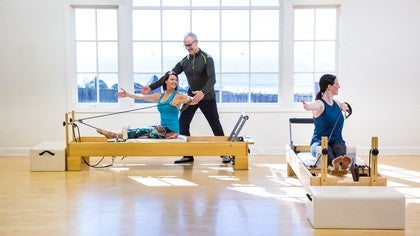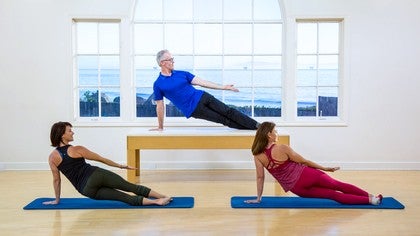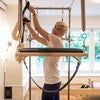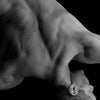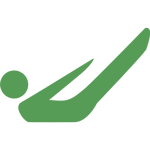Description
About This Video
Transcript
Read Full Transcript
Hi, everybody. This is Tom McCook. Back here at Pilates anytime. And this tutorial is, based on a question I get a lot from students who are becoming teachers or they're looking for ways to help their students get more out of the classes, learn how to self correct better, and learn how to actually direct their attention in a way that's gonna help them get the most out of their private sessions and their personal workouts when they're alone or whether they're taking a, a group or a class. And, there's some key things that I've used over the years that have been really useful from teachers I've learned from and just from a lot of teaching experience. So one thing that's really valuable is to teach your clients self touch for position and where movement's happening. So, for example, if you just have somebody bend their legs and put their hands in the crease of their pelvis halfway in the middle of the crease, have them put their fingers in the crease and directly behind their fingers now is where the legs meet the pelvis.
So you're sharing with them the primary joint in the lower body where movement happens, which is the hip joint, then you can go through the simple movements that happen there. Knee lifting, pelvic hinging over the legs, and squatting are all variations of what happens at that joint. So just starting with touch, having them touch there, does two things. It gives them location, Where you want the movement to happen, which improves function and a place to put their attention to notice are they using it correctly or not? That's really key because if you don't know, you're kind of unsure, and I've been teaching Pilates for over thirty years now, And early on in my training, I wasn't taught where the hip joints were. I learned that more in the Franklin method. Not that, you know, anybody that I learned from wasn't a good teacher.
It just wasn't something they learned to teach their clients how to touch as a way to to improve proprioception and directing attention. So that's number one for one area. The other thing you could have them just put their heel of the hands on the front of the hips and their fingertips on their pubic bone to feel the difference between a neutral pelvis, a tucked pelvis, or an arched lower back, just to go back and forth between the three as a movement exploration so the client can feel the difference, notice what their muscles feel like, and notice what it does to the rest of their body. So these things only take a minute and they're super helpful. And I recommend that you you go through that setup in every position change that you do with somebody, whether they're going from standing to supine on their back, to seated on the floor, to sideline that you take a moment to give them a feeling of where how are they aligned and how to touch their own body so they can start to direct their own correction instead of overly relying on the teacher. Now, pelvis is one. Another place is the head.
So right below the ears, if you touch the bones right below your ears, they're called the mastoid process, big robust bone. Straight in from the fingers is where the head sits on the spine. So given somebody that feedback to touch that, and then just do the simple nod and extension, oh, that's where my head sits on the spine. They're gonna notice if throughout here, And then they can start to self correct. You can give them a little bit of feedback, but now you gave them another place to put their attention on. And it's also where the initial movement happens when we flex the spine from the top down, like in the hundreds, roll up all these movements, That's the initiation point.
So you're giving a another key area to learn to focus on, but also improve their posture and how they relate to gravity. So that's really, really valuable. I personally don't think people have an attention problem. I think they don't know to put their attention. So when you have nowhere to put it, then you can create you can cultivate your ability to pay attention while you're moving and what you're using, how you're using your mind to improve the quality of your experience.
So that's a really important thing. Another area would be the ribs. A lot of Tom, if we're tend to be, more contracted in our back, the rib cage can be sheared forward. So you can just give them feedback of putting their thumbs around their back low ribs and just get a sense of rib cage over pelvis and then head or in the top. So you're just giving awareness of Oh, that's that's a that's a very mobile place for a lot of us right where the lower back and the ribcage meet.
Just having them touch there and then breathe into their hands. So they can feel that lateral expansion of the ribs. From the lungs and get an awareness of, oh, that's designed to move. And I can align it a little better just with a little bit of awareness. That's really helpful.
Another place to have them put their attention without touching would be their feet. So if you have somebody lift their 10 toes off the floor, it's easier to feel their key weight bearing points of their feet. The ball behind your big toe, the ball behind your little Tom, and your heel. Picture like a triangle on each foot. Just have them lift and lower their toes a few times and just start to feel, you can even just ask them, notice where you're feeling the weight on those three points.
These one of the points tending to be left out, the most common point that's left out is the front lateral point, the point behind the little Tom. Cause statistically, we tend to lean more into what's called pronation, more weight on the inner edges of the feet. So just giving people that feedback to go, okay, I wanna see if I can make it a little more balanced on those three. I've already done a lot to improve my leg alignment and my posture. Super valuable. And that can be anytime they're standing on the jump board or on the foot bar.
If they're on their forefoot, keep those two foot points, on the bar. Very helpful for leg alignment. So it's cleaning up your ability to cue them and have them do the exercise better, and more efficiently. Another thing, when people are moving, have them focus on and guide them through in your queuing of where they're initiating the movement from. For a roll down or a bridge, they're initiating the movement from the pelvis, like a pelvic wheel rolling back, if it's an articulated bridge.
And then you, as a teacher, notice if that's happening. If it's coming from the top, they're moving from their head down, have them focus on where they're initiating from is a great way to teach people how to move more efficiently and activate the correct muscles. Another great way to help people move better, get more out of your class, but also make the transition from their life when they came in from their job or whatever they were just doing. Is to do stuff to help them release tension, which actually does have several really important things that can improve posture, help them sense themselves better. They're gonna have better proprioception and body awareness, and help them become more present and connected on a physical level more in a feeling state. So you can have them do hip massages with balls.
You can have them do self sponging and tapping. All of these things are great tools as a lead in into your workout because you're upping the quality of their attention and their body's ability to feel. A few very useful minutes at the beginning of a class. Think of it another way. You can't override attention pattern to improve your moving quality.
It's really helpful and useful to release tension so then you can introduce a new movement pattern with focused attention and moving slowly. And that brings up my next point. If somebody's their movement quality, just you're trying to improve it and they're tending to just a little too quick, slow them down. Help them do the movements slower with more control and feel their muscles a little bit more. We can rush through and exercise, and it's actually you're skipping over the parts of the body that don't get as much that need the work.
Know, we can be, we can be a little crafty and sneaky that way. A great way to do that is have people use props, whether they're holding a ball between their knees, using a ring, using a theraband, to guide them into better muscle activation, and learning how to feel themselves while they're doing the movement, putting that as an emphasis, feeling what I'm doing while I'm doing it. And then, you know, lastly, and most importantly, helping them enjoy the the the process of learning by being curious about how to do it well. I hope this is helpful. If you have any questions, you know, you can let us know through the blog, through, pilates anytime, and, we appreciate your time in in supporting you and being your best that you can be in your teaching and in your own practice.
Thanks for joining.
The Teacher's Corner: Embrace How You Teach
Comments
You need to be a subscriber to post a comment.
Please Log In or Create an Account to start your free trial.

